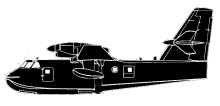
ASN Wikibase Occurrence # 322658
| Date: | Monday 8 March 2004 |
| Time: | 11:15 |
| Type: |  Canadair CL-215-6B11 (CL-415) |
| Owner/operator: | Securité Civile |
| Registration: | F-ZBEZ |
| MSN: | 2018 |
| Year of manufacture: | 1996 |
| Total airframe hrs: | 2484 hours |
| Engine model: | Pratt & Whitney Canada PW123AF |
| Fatalities: | Fatalities: 2 / Occupants: 3 |
| Aircraft damage: | Destroyed, written off |
| Category: | Accident |
| Location: | Lac Sainte Croix -
 France France
|
| Phase: | Landing |
| Nature: | Training |
| Departure airport: | Marseille-Provence Airport (MRS/LFML) |
| Marseille-Provence Airport (MRS/LFML) | |
| Investigating agency: | BEAD |
| Confidence Rating: |
At 09:30, the Canadair with callsign Pelican 41 took off from Marseille-Provence Airport for the Lac Sainte-Croix which is one of the water bodies usually used for training flights. After 01:20 of flight, the instruction phase for the first trainee was completed. When the Canadair stopped on the lake, the two co-pilots switched places. The second trainee took the controls and began his training session with hydroplaning in accordance with the training program. Before starting the next exercise, the instructor reminded the trainee of the actions to be taken to achieve this phenomenon. He reminded that the speed must remain below 55 kt. The trainee, still at the controls, extended the flaps to 10°, the takeoff configuration. He then proceeded to accelerate the aircraft by advancing the throttle to obtain an engine torque close to that required for takeoff. As the Canadair accelerated, the trainee applied elevator to initiate the porpoise. The airspeed continued to increase and the Canadair took off without the porpoising phenomenon having occurred. The trainee moved the power levers to minimum.
The aircraft struck the water and the crew felt a shock. As the aircraft continued to move through the water in deceleration, the instructor pointed out to the trainee the loss of the right-hand float. The instructor decided to abort the training mission and took over the controls to return to the Marseille-Provence Airport. The instructor then undertook to take off. As soon as the aircraft took off, it slowly tilted to the right even though the control column was positioned to the left. The instructor then positioned the control column to the left, but the bank continued to increase. The instructor told the two co-pilots that he was having difficulty controlling the aircraft. The co-pilot trainee, sitting in the middle seat, suggested switching to manual control. The instructor did not accept this option and put the aircraft in descent. He asked the trainee in the right seat to put the flaps in the 25° position which corresponded to the landing configuration. The aircraft, still banked and descending, hit the water with its right wing. The instructor and the trainee in the center seat died. The trainee in training was seriously injured.
CAUSES OF THE ACCIDENT (translation from French report)
The accident is the consequence of a chain of causes of human origin which lead to the loss of control in roll of the aircraft:
The accident can be broken down into 2 phases:
- A first phase that leads to the damage of the flight controls during the impact with the water following the stall of the aircraft. The stall is the result of the trainee's failure to execute the flight controls, which was not countered by the instructor. The trainee's failure to perform at the very beginning of Canadair training was part of a context of:
-- a failure to comply with the training framework: Contrary to what the progression booklet states, the instructor did not demonstrate the porpoising. He entrusted the commands to the trainee.
-- pedagogical error: The instructor did not follow a trainee who was performing an exercise for the first time.
-- lack of control of the parameters (speed) by the crew.
- A second phase that lead to the loss of the aircraft and part of its crew. It resulte from an underestimation of the damage to the aircraft during the impact with the water and from the decision of the captain to take off without checking the flight controls.
It is common practice for crews to continue flying loss of a float during a scoop. The instructor assimilated the circumstances of the float loss he was confronted with to those already encountered during scooping operations. He proceeded with the takeoff without checking the flight controls that were damaged during the stall.
Accident investigation:
 |
|
Sources:
Air Forces Monthly, May 2004
Location
Revision history:
| Date/time | Contributor | Updates |
|---|
The Aviation Safety Network is an exclusive service provided by:


 ©2024 Flight Safety Foundation
©2024 Flight Safety Foundation